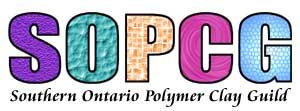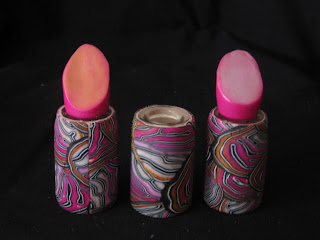Barbara also did an amazing job on the lids, so check later for an up-coming post on lids.
Step 1: Start with a Skinner blend. There are lots of wonderful internet postings on how to do this blend, so instead of telling you here, we'll inspire you with samples of some of the blends made by guild members.
You can see that the color palettes vary but they all yield great results. Cathy recommends using metallic or pearl colors for best results when using cane slices.
Here's a tip from Barbara C: make your Skinner blend in your favorite colors and when you're done, add a layer of white pearl on top and blend. Your colors will be a little lighter and all pearl.
Now run your Skinner blend through the pasta machine feeding one solid color in first on the thickest setting. Do this twice more on thinner settings until you have your blend on the third thickest setting. Set aside.
Make a sandwich of conditioned clay using : black, white and black again. Run through the pasta machine on the thickest setting and repeat twice more until it is at your third thickest setting.
Now join the elongated Skinner blend and the black/white/black sheet. Run though the pasta machine at the thickest setting and once more to reduce to your second thickest.
You may need a friend for this part: Hold your hand under the bottom mouth of the pasta machine. Run the resulting sheet through your third thickest setting while moving your hand under the machines backwards and forwards "crumpling" the clay rather than letting a smooth sheet come out. Leave a "tail" of about 3 inches and run through the machine without crumpling.
Roll the crumpled clay into a log and wrap the tail with the black edge on the outside of the cane. Squeeze the middle and roll to reduce and remove air pockets.
Your cane is ready to use.
Cathy recommends laying slices on a matching, complimentrary or contrasting color and reduce a couple of times through the pasta machine to let the metallic/glitter shine.
Here are some finished cane samples as well as a covered Bottle of Hope.
Cathy loves to try a new twist on a polymer basic and the Brain Cane was no exception. On this cane she inserts a white and black bullseye cane and the result is reminiscent of a monarch butterfly's wing.
There are also lots of variations possible by changing the Skinner blends - monochromatic, analogous, complimentary color schemes for example. One member changed the black and white sandwich to gold/green/gold with great results. Why not give the Brain Cane a try in your favorite color scheme?
















